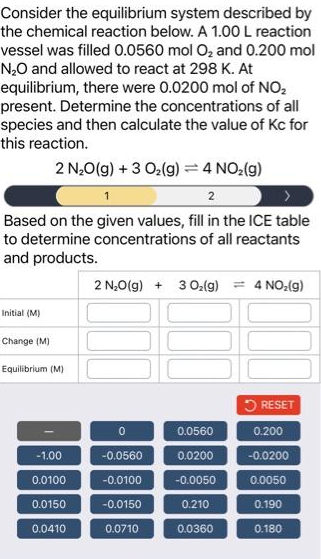Consider the equilibrium system described by the chemical reaction below. A 1.00 L reaction vessel was filled 0.0560 mol O, and 0.200 mol N,O and allowed to react at 298 K. At equilibrium, there were 0.0200 mol of NO, present. Determine the concentrations of all species and then calculate the value of Kc for this reaction. 2 N,O(g) + 3 02(g) = 4 NO:(g) 1 2 Based on the given values, fill in the ICE table to determine concentrations of all reactants and products. 2 N,O(g) + 3 0:(g) = 4 NO:(g) Initial (M) Change (M) Equilibrium (M) 5 RESET
Consider the equilibrium system described by the chemical reaction below. A 1.00 L reaction vessel was filled 0.0560 mol O, and 0.200 mol N,O and allowed to react at 298 K. At equilibrium, there were 0.0200 mol of NO, present. Determine the concentrations of all species and then calculate the value of Kc for this reaction. 2 N,O(g) + 3 02(g) = 4 NO:(g) 1 2 Based on the given values, fill in the ICE table to determine concentrations of all reactants and products. 2 N,O(g) + 3 0:(g) = 4 NO:(g) Initial (M) Change (M) Equilibrium (M) 5 RESET
Principles of Modern Chemistry
8th Edition
ISBN:9781305079113
Author:David W. Oxtoby, H. Pat Gillis, Laurie J. Butler
Publisher:David W. Oxtoby, H. Pat Gillis, Laurie J. Butler
Chapter14: Chemical Equilibrium
Section: Chapter Questions
Problem 39P
Related questions
Question

Transcribed Image Text:Consider the equilibrium system described by
the chemical reaction below. A 1.00 L reaction
vessel was filled 0.0560 mol O, and 0.200 mol
N,O and allowed to react at 298 K. At
equilibrium, there were 0.0200 mol of NO,
present. Determine the concentrations of all
species and then calculate the value of Kc for
this reaction.
2 N,O(g) + 3 0:(g) = 4 NO:(g)
2
Based on the given values, fill in the ICE table
to determine concentrations of all reactants
and products.
2 N,O(g) + 30:(g) = 4 NO:(g)
Initial (M)
Change (M)
Equilibrium (M)
RESET
0.0560
0.200
-1.00
-0.0560
0.0200
-0.0200
0.0100
-0.0100
-0.0050
0.0050
0.0150
-0.0150
0.210
0.190
0.0410
0.0710
0.0360
0.180
Expert Solution
This question has been solved!
Explore an expertly crafted, step-by-step solution for a thorough understanding of key concepts.
This is a popular solution!
Trending now
This is a popular solution!
Step by step
Solved in 3 steps with 3 images

Knowledge Booster
Learn more about
Need a deep-dive on the concept behind this application? Look no further. Learn more about this topic, chemistry and related others by exploring similar questions and additional content below.Recommended textbooks for you

Principles of Modern Chemistry
Chemistry
ISBN:
9781305079113
Author:
David W. Oxtoby, H. Pat Gillis, Laurie J. Butler
Publisher:
Cengage Learning

Chemistry: Principles and Reactions
Chemistry
ISBN:
9781305079373
Author:
William L. Masterton, Cecile N. Hurley
Publisher:
Cengage Learning

Chemistry: The Molecular Science
Chemistry
ISBN:
9781285199047
Author:
John W. Moore, Conrad L. Stanitski
Publisher:
Cengage Learning

Principles of Modern Chemistry
Chemistry
ISBN:
9781305079113
Author:
David W. Oxtoby, H. Pat Gillis, Laurie J. Butler
Publisher:
Cengage Learning

Chemistry: Principles and Reactions
Chemistry
ISBN:
9781305079373
Author:
William L. Masterton, Cecile N. Hurley
Publisher:
Cengage Learning

Chemistry: The Molecular Science
Chemistry
ISBN:
9781285199047
Author:
John W. Moore, Conrad L. Stanitski
Publisher:
Cengage Learning

Introductory Chemistry: A Foundation
Chemistry
ISBN:
9781337399425
Author:
Steven S. Zumdahl, Donald J. DeCoste
Publisher:
Cengage Learning

Chemistry for Engineering Students
Chemistry
ISBN:
9781337398909
Author:
Lawrence S. Brown, Tom Holme
Publisher:
Cengage Learning

General Chemistry - Standalone book (MindTap Cour…
Chemistry
ISBN:
9781305580343
Author:
Steven D. Gammon, Ebbing, Darrell Ebbing, Steven D., Darrell; Gammon, Darrell Ebbing; Steven D. Gammon, Darrell D.; Gammon, Ebbing; Steven D. Gammon; Darrell
Publisher:
Cengage Learning